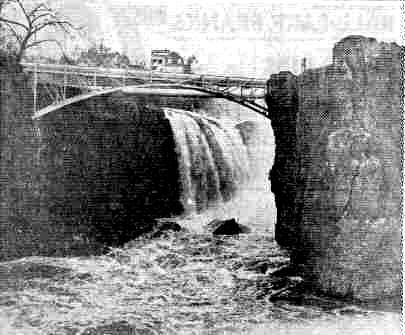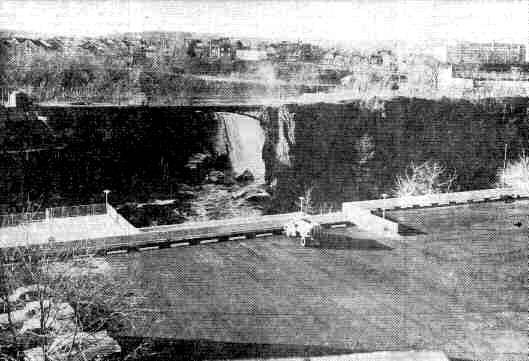
The Morning News, Paterson, N.J., May 6, 1970, pp. 1, 4.

Mighty Cataract -- The Passaic Falls thundering at full flood
into the rocky gorge 75 feet below is the focal point of the 89-acre National
Historic Site, so designated by the Federal Government's Department of the
Interior, in an announcement released today by Mayor Lawrence Kramer, culminating
a quiet 2-year campaign for recognition. (News
photo)
Mayor Lawrence F. Kramer announced Tuesday that he has received notification
from U.S. Senator Clifford P. Case and Eight District Representative Robert
A. Roe, that an 89 acre site covering the Passaic Falls, some 40 aging mill
buildings, and the three level raceway, has been designated a National Historic
district.
"It's exciting and thrilling news," said Kramer, who since the first year
of his administration has been leading a quiet but determined campaign to
have Paterson given the recognition it deserves.
In this role, Kramer joined a long list of leading local figures, spearheaded
by Harry B. Haines, publisher of the Paterson news, and involving Passaic
county Congressmen George N. Seger, Gordon Canfield, Charles Joelson and
incumbent Roe, and U.S. Senator H. Alexander Smith and Case.
Things looked brightest back in 1966 when Interior Department Secretary Stewart
Udall made a personal survey of the falls area during a tour of metropolitan
area historic sites for "Mission 66." This was a project to set up a federal
registry of National Historic Landmarks.
But when the list came out in Nov. 1967 the Passaic Falls wound up with only
a brief honorable mention.
The Advisory Board on National Parks, Historic Sites, Buildings and Monuments,
acting on Udall's report, designated the Falls only as a National Registered
Landmark. This was believed to be something of a consolation prize for all
the efforts put into the local campaign for recognition of this city's historic
role as first industrial City in the new world.
At that time, the National Parks Service rejected this contention, and what
was even more galling, chose to designate a single mill building in Slatersville,
R.I. as a National Historic Landmark, as the cradle of U.S. industry.
In time, the city received a bronze plaque from the Department of the Interior
designating the Passaic Falls as worthy of inclusion in the National Registry
of landmarks.
But Mayor Kramer and a handful of Paterson "loyalists" that included Mr.
Haines, Mr. Canfield, Dr. D. Stanton Hammond and a number of others refused
to accept the rebuff.
The plaque was "filed" in a corner of the Paterson Park board office and
the campaigners regrouped to continue the fight.
At the time, Kramer notified the Department of the Interior that "while Paterson
does not intend to declare war on Slatersville," he was determined to set
the historical record straight.
"History is important," Kramer said, "and we are serious about our historic
legacy." He urged the Interior Department to re-examine and reevaluate Paterson's
role and that of the Society for Useful Manufactures, around which the city
grew to become the first industrial capital of the New World.
The initial committee that had worked with Kramer s predecessor, Mayor Frank
X. Graves Jr., to create an overlook park at the Falls site was re-organized
without fanfare and began a persistent but quiet campaign to "set the record
straight."
Heading this group was Mrs.Mary Ellen Kramer, wife of the mayor. Among its
members were Mrs. Samuel (Esther) Schwartz. a member of the National Restoration
Committee for Historic Shrines; Frank Blesso of the Paterson Redevelopment
Agency; John Bell, director, Model Cities, Works Board Commissioner Tippi
Krugman and Donald Ferguson, senior planner of the Paterson Planning Board;
Leo Fichtelberg, director, Paterson Library; Dr. Hammond and Edward Graff
of the. Passaic County Historical Society.
Through what seemed almost like an act of providence, this committee was
joined later by John Young, New York City architect of Urban Deadline
Inc. and Columbia University, who wrote the application.
His major role in the project will be detailed in a following article spelling
out in detail the campaign that led to the Department of Interior's complete
reversal of its earlier position.
Charles Jacobs, Paterson industrialist, worked closely with the committee
and Mr. Haines continued to lend his support and influence in the quiet but
unflagging campaign.
Within six months, the committee had won the interest of Charles E. Peterson,
FAIA, architectural historian and restoration and planning consultant of
Philadelphia, who came here to make a survey of the Falls area and quickly
caught the committee's enthusiasm.
"Paterson," he declared at the time of his visit, "stands as the historic
dividing line between America's agricultural and industrial development."
The city's designation as a National Historic Site has far greater significance
than if the Falls had been given the original designation as an historic
landmark. This covers not just the Falls but the entire area of 89 acres.
As a National Historic site, it will be eligible for a number of federal
programs and matching grants for restoration and improvement of the site,
preservation, rehabilitation and restoration of structures.
Tentative plans for development of the site to make it worthy of the designation
call for upgrading of the area buildings with continued utilization, expansion
for industrial purposes and beautification of the raceway and necessary buildings
such as the old Ivanhoe House, its dams and gateworks.
The mill buildings, most still in operation, cover the years from 1793 to
1912 represent a living chronicle of the growth of industry in the new World
from its beginnings through the Industrial Revolution and the birth of the
nation's modern industrial might.
The present cultural committee responsible for this achievement is to be
expanded and broadened to include every segment of society and every age
group.
According to Mrs. Kramer, "We anticipate the involvement of all the people
of Paterson in this endeavor, from the boys and girls of the Neighborhood
Youth Corps to our senior citizens."
"This is one of the proudest moments of my administration," said Kramer.
"It is the realization of a dream, not only by those citizens of Paterson
today but many who could not live to see its fulfillment."
"This is our sacred trust, to make meaningful this designation of the Falls
area as a National Historic Site; to preserve this priceless legacy for this
and future generations, and in the memory of those long gone whose hands
and hearts were part of its building."

Overlook Park at the Passaic Falls, created in 1964 during administration of former Mayor X. graves, Jr., and sparked by harry B. Haines, Paterson news Publisher, marked the city's recognition of its historic heritage since its beginnings, the establishment of the Society for Useful Manufacturers by Alexander Hamilton in 1791. Statue of Hamilton (not shown) graces the Plaza showing him looking over the falls whose vast power potential prompted him to create first industrial city of the new world on its banks. (News photo)